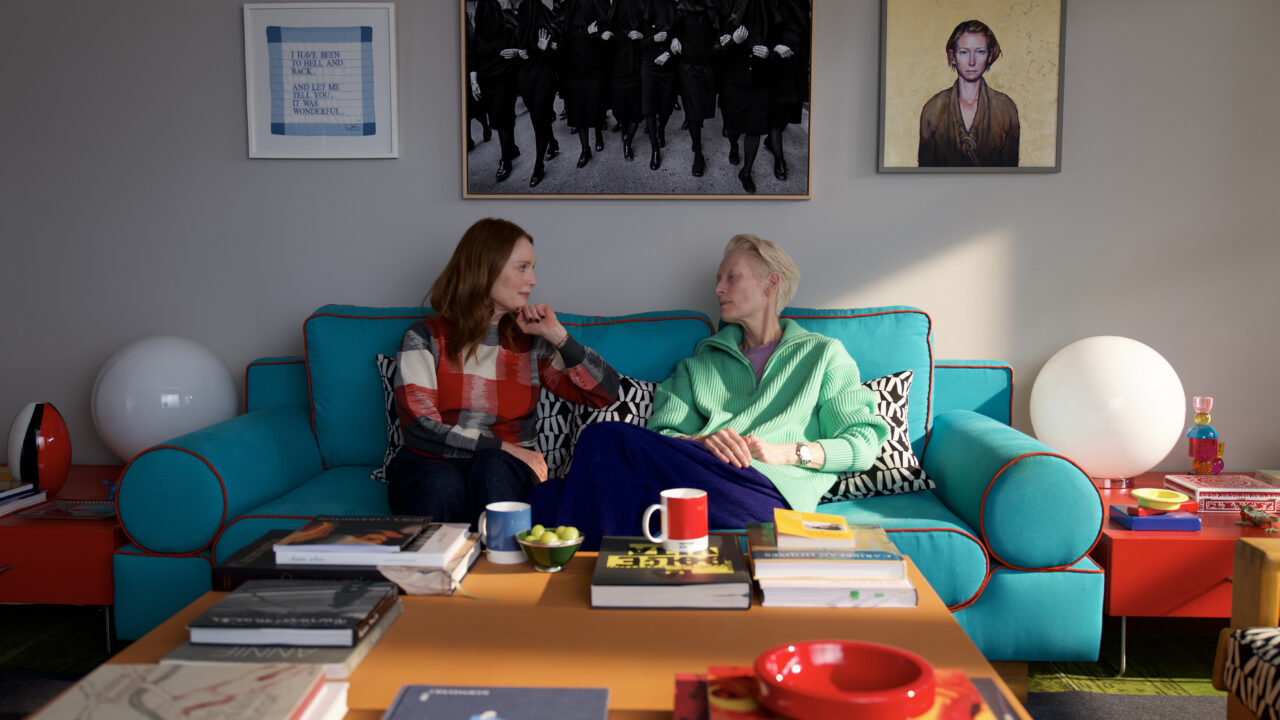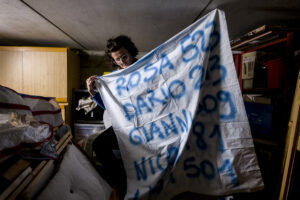Rooms of Joy and Sorrow
Cinema’s most striking colorist paints a scene from the end of life. Julianne Moore and Tilda Swinton in "The Room Next Door." (Courtesy of Sony Pictures Classics)
Julianne Moore and Tilda Swinton in "The Room Next Door." (Courtesy of Sony Pictures Classics)
Pedro Almodóvar is not only an accomplished filmmaker, but also a gifted painter. Whether on screen or canvas, his compositions are known for their striking use of color. So it is with the Spanish filmmaker’s first movie in English, “The Room Next Door,” where crimson reds and sage greens color-code the contrasting personalities of the leads. Martha (Tilda Swinton) is a fiery war correspondent in the throes of third-stage cervical cancer. Ingrid (Julianne Moore), patience personified, is a measured writer whose new book explores her fear of death. At a bookstore signing, Ingrid hears of Martha’s hospitalization and visits her, rekindling a friendship with the woman she met when both were starting out. Together they confront the question at the heart of the film: Should the terminally ill embrace their mortality, or buy a one-way ticket for what Shakespeare called the undiscovered country?
Based on the Sigrid Nunez novel, “What are You Going Through,” Almodóvar’s adaptation concerns two women of markedly different temperaments. Martha is an adrenalin junkie who sees life through the lens of armed conflict and is fond of bold pronouncements; Ingrid is a sympathetic listener who empathizes with Martha’s battle-weariness and insistence that “Cancer can’t get me if I get me first.”
Ingrid confides in Damian (John Turturro), a climate-change scientist once serially involved with both women, about Martha’s health woes. For Damian, another figure prone to making pronouncements and seeing life through the lens of his work, Martha is a doomed, dying woman in a doomed, dying world. Ingrid pushes back on his diagnosis. “There are lots of ways,” she says to Damian, “to live inside a tragedy with joy.”
Almodóvar bathes his third act in the golden glow of sunset’s magic hour.
During the film’s hospital sequences, Swinton’s Martha hovers like an irritable ghost up to her white hair and lips with impatience. Chemo brain has made it impossible for her to write. The meds she takes to regulate her mood have her swinging between euphoria and depression. She doesn’t want to spend her last days in death’s waiting room, guinea pig for an experimental cancer treatment.
On break from the hospital and chemotherapy, Martha looks forward to walks outside with Ingrid and to thinking more clearly. She tells her friend that she has rented an upscale Airbnb “near Woodstock.” (It is really a celebrated modernist house, Casa Szoke, northwest of Madrid, adjacent to a forest of resplendent lodgepole pines.) When she invites Ingrid to join her, there’s a string attached — or is it a noose? When the time feels right, Martha plans to self-euthanize via a suicide pill, after leaving a note for police saying that Ingrid had no knowledge of her intentions.
Wanting to support a friend, yet wary of being an accessory to a crime, Ingrid withholds her answer. It is at the house where the movie’s tension escalates, as do its many pleasures. Remarkably, in this film about raging against the dying light, Almodóvar bathes his third act in the golden glow of sunset’s magic hour and the cathartic silences between the women. There are two ways to live inside a tragedy with joy. Almodóvar’s movie is a third.
Your support is crucial...As we navigate an uncertain 2025, with a new administration questioning press freedoms, the risks are clear: our ability to report freely is under threat.
Your tax-deductible donation enables us to dig deeper, delivering fearless investigative reporting and analysis that exposes the reality beneath the headlines — without compromise.
Now is the time to take action. Stand with our courageous journalists. Donate today to protect a free press, uphold democracy and uncover the stories that need to be told.







You need to be a supporter to comment.
There are currently no responses to this article.
Be the first to respond.